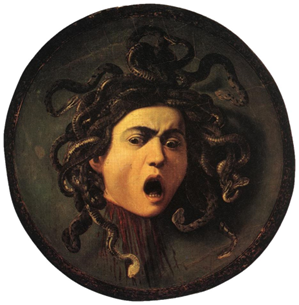Harry Rao reflects on how Medusa connects with being autistic
Introductory Note: From Hercules to Medusa with Harry Rao
Harry Rao, the author of an article for ACCLAIM on Hercules, turns now to Medusa and how this figure too can resonate with being autistic.
Harry has recently graduated with a BA in Classical Civilisation from Roehampton University in London and is currently studying classical reception for his master’s degree at University College London.
Susan Deacy, susan.deacy@bristol.ac.uk
Medusa and the Duplicity of Appearance vs Reality in Relation to Autism and Neurodivergent Individuals
What is Medusa? You see a head with snakes, a petrifying gaze. Perhaps you see a green-skinned monster whose repulsion and horror vanquishes anything she sets her eyes on.

Figure 1: Michelangelo Merisi da Caravaggio, Medusa, c. 1597. Rotella (tournament shield) in oil on canvas mounted on wood, Uffizi Gallery, Florence, Italy. Image sourced from Wikimedia Commons. In the public domain.
But when you look beneath the mask and façade of horror there is same unified humanity that binds all people. When you look beneath, you find out that a sense fear vulnerability and emotional insecurity is hidden behind a repulsive demeanour.
For people with autism the idea – the place, a façade – is sometimes unconsciously erected as way of hiding emotions that a person cannot express. This enables the outside world only to envision a certain aspectof an autistic individual’s psychological disposition.
A potentialized theory in my experience is that neurodivergent people create this illusory barrier as way to protect and secure themselves from an outside world that might not understand them, the way Medusa utilizes her gaze as a defensive mechanism to ward off threats. The metaphor of Medusa’s appearance does not always match reality the fear and insecurity of rejection and misunderstanding a personwith autism might fear. And because they are potentially capable expressing emotions, they put up a façade of normalcy intended to repel the outside world, something I myself as someone with autism has done.
The overall message behind Medusa and dichotomized predicament of reality versus appearance is that any person especially, a person who is neurodivergent, must embrace their diversity and show it to the world as an expression of their individual humanity. These traits make them gifted and special and like Medusa’s stare, an autistic person’s diversity is capable of replicating and expelling a truly remarkable form of potential unique to them.
Some suggestions for further reading
Ancient poetry dealing with Medusa:
- Hesiod, Theogony, lines 270–285, Loeb translation (1914), taken from the Perseus Catalogue. Available online here.
- Ovid, Metamorphoses, Book IV lines 753–803, translated by A.S. Kline (2000). Available online here.
Modern novels of Medusa:
- Jessie Burton, Medusa: A Beautiful and Profound Retelling of Medusa’s Story, London: Bloomsbury, 2023.
- Anwen Kya Hayward, Here, the World Entire, 2016, ebook.
By Harry Rao
harsha.rao23@ucl.ac.uk
December 2023








